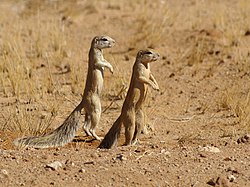| Geosciurus | |
|---|---|
 | |
| Cape ground squirrel (Geosciurus inauris) | |
| Scientific classification | |
| Kingdom: | Animalia |
| Phylum: | Chordata |
| Class: | Mammalia |
| Order: | Rodentia |
| Family: | Sciuridae |
| Tribe: | Xerini |
| Genus: | Geosciurus A. Smith, 1834 |
| Type species | |
| Sciurus capensis | |
| Species | |
2 sp., see text | |
The genus Geosciurus of African ground squirrels are found in most of the drier parts of southern Africa from South Africa, through to Botswana, and into Namibia.




